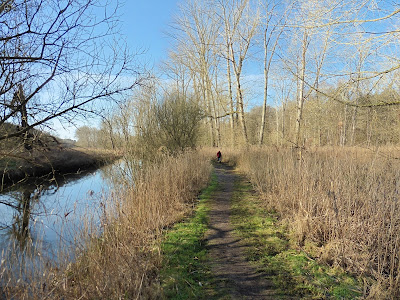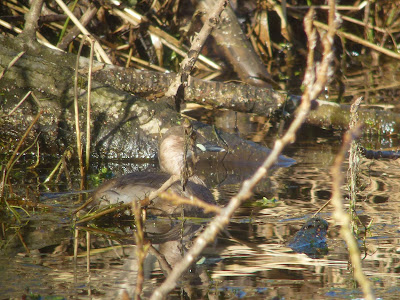A bright late winter’s day was ideal to check out some places in the Brecks for a future local Honeyguide event, and Rob Lucking, Julie and I met in the Forestry Commission’s car park at Santon Downham. That’s just into Suffolk, though as soon we’d crossed the bridge to walk alongside the river Little Ouse we were in Norfolk.
We weren’t the only people out today: the steady trickly of birdwatchers were mostly here as this is one of the very few places to see lesser spotted woodpecker nowadays. The reason was immediately apparent: this is nothing like the typical conifer plantations of so much of the Brecks. Instead, this river valley has a mix of open areas and deciduous trees, mostly poplars, with very obviously a lot of standing dead timber, which ‘lesser spots’ like.
 |
| Little Ouse at Santon Downham. |
 |
| Another general view by the Little Ouse at Santon Downham. |
In a tangle of branches in the Little Ouse a little grebe surfaced, then two, then three. They were surprisingly close, perhaps thinking that they were out of sight. The literature talks about a pale or yellow patch at the base of the bill: today it was distinctly pale green in colour. A water rail flew behind Rob; we heard Cetti’s warbler and the flight calls of siskins; there were various tits, including marsh tit.
 |
| Little grebe (digiscoped). |
After a short while we heard the sound of a gentle, yet fast, drumming. It took a little while, but soon a lesser spotted woodpecker flew through and settled on open branches. It was still enough for a digiscoped photo: to say the picture won't win any prizes is an understatement, but you can see what it is, a female lesser spot, with no red on the head. This and a second bird flew on.
 |
| Lesser spotted woodpecker, female (digiscoped). |
A little farther on, we found what we are pretty sure were two more lesser spots. Some passers-by told us that birdwatchers were watching our first birds as we enjoyed this second pair. There was more drumming, and a male lesser spot investigated a hole in a dead branch before being scared away by a great spotted woodpecker that then went into the hole. We also found a treecreeper.
On the way back we took a little detour under the railway line and through a patch of heathland. There were two stonechats and a birdwatcher here had seen a woodlark before we arrived, though our timing wasn’t ideal as someone was flying a drone over the heath.
 |
| Some Breck heath. |
We made a fairly quick visit to the churchyard in the village as firecrest was reported here, but no luck.
 |
| Santon Downham church. |
We drove onto Brandon County Park to eat picnics on the benches there, grab a cup of tea and look into the walked garden. Then we walked – a very short walk – to the large pond where, with the expected mallards, were 15 mandarin ducks. They are tame here and come to bird food, though they are undeniably beautiful.
 |
| Mandarin drakes and ducks; nine of the fifteen at Brandon Country Park today. |
The final stop was Lynford Arboretum, just north of Mundford. We were lucky enough to be there for two brief appearances of hawfinches. There were several marsh tits, nuthatch, redwing and a long-tailed tit. A flock of birds were feeding under some tree: mostly chaffinches, some bright yellowhammers and three or four bramblings. Another birdwatcher had his telescope set up looking into a tall fir tree: his target took a bit of making out, but it was a tawny owl.
Chris Durdin




No comments:
Post a Comment